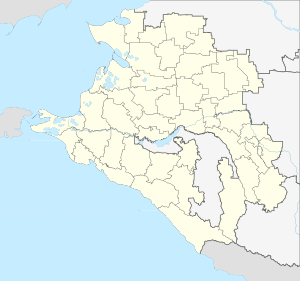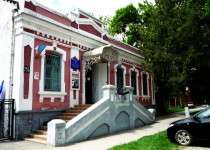Slavyansk-na-Kubani
| Slavyansk-na-Kubani Славянск (Russian) | |
|---|---|
| - Town[1] - | |
.jpg) Welcome sign at one of the entrances to the town | |
.svg.png) Location of Krasnodar Krai in Russia | |
 Slavyansk-na-Kubani | |
_(12-2006).png) |
.png) |
Coat of arms |
Flag |
| Administrative status (as of May 2013) | |
| Country | Russia |
| Federal subject | Krasnodar Krai[1] |
| Administratively subordinated to | Town of Slavyansk-na-Kubani[1] |
| Administrative center of | Town of Slavyansk-na-Kubani,[1] Slavyansky District[1] |
| Municipal status (as of June 2009) | |
| Municipal district | Slavyansky Municipal District[2] |
| Urban settlement | Slavyanskoye Urban Settlement[2] |
| Administrative center of | Slavyansky Municipal District,[2] Slavyanskoye Urban Settlement[2] |
| Statistics | |
| Population (2010 Census) | 63,842 inhabitants[3] |
| - Rank in 2010 | 247th |
| Time zone | MSK (UTC+03:00)[4] |
| Town status since | 1958[5] |
| Website |
cityslav |
| Slavyansk-na-Kubani on Wikimedia Commons | |
Slavyansk-na-Kubani (Russian: Славянск-на-Куба́ни) is a town in Krasnodar Krai, Russia, located in the Kuban River delta. Population: 63,842 (2010 Census);[3] 64,136 (2002 Census);[6] 57,790 (1989 Census);[7] 56,000 (1975).
History
Slavyansk originated in the Middle Ages as Copa or Coparia, a Genoese trade outpost controlled by the Ghisolfi family. After the fall of the Genoese power in the Pontic region, the site was abandoned until 1747 when the Crimean Khanate erected a small fort, known in Russian sources as Kopyl.
After the conquest of the Taman Peninsula by the Russian Empire, the Tatar fort gave way to the Cossack stanitsa of Kopylskaya. In 1865, it was renamed after the Slavyansky regiment that had been quartered there under Catherine the Great. In 1958, it was incorporated as the town of Slavyansk-na-Kubani (so called in order to distinguish it from the eponymous city in Ukraine).. The history of Slavyansk dates backs to the end of the 18th century. This town was a fortress founded by General Suvorov to defend the southern borders of Russia. In 1865 the fortress became a Cossack stanitsa. During World War II this town was occupied by the fascists and it was liberated in 1943. The town features monuments to those who were lost in the war.
Toponymy
The town's name is derived from the name of the village Slavyanskaya in 1958.[5] Slavyansk has already existed since the USSR in the Donetsk region so a city name added clarification "-on-Kuban". The name was given to the village by name strengthen "Slavic feldshanets" Slavic Hussars, which had been under the command of Alexander Suvorov on the right bank of the Kuban.
Different sources give different emphasis to the name “Slavyansk” - on the first and the second syllable, however, the locals accepted the name Slavyansk on the first syllable.
Geography
The city is located on the banks of the river ducts in the Kuban Delta, 68 km from Krasnodar. Floor space is 20 square kilometers, along the administrative border - 39,5 km ².
There is a railway station on Protoka Timashyovsk line - Crimea.
Administrative and municipal status
Within the framework of administrative divisions, Slavyansk-na-Kubani serves as the administrative center of Slavyansky District, even though it is not a part of it.[1] As an administrative division, it is incorporated separately as the Town of Slavyansk-na-Kubani—an administrative unit with the status equal to that of the districts.[1] As a municipal division, the Town of Slavyansk-na-Kubani is incorporated within Slavyansky Municipal District as Slavyanskoye Urban Settlement.[2]
Attraction
- Slavonic Museum of Local History
 Slavonic Museum of Local History
Slavonic Museum of Local History - Slavonic Museum of Nature MUK
- Dormition Cathedral (1907), designed by the famous architect of the Kuban Kosyakin
- Monument to A.V. Suvorov
- Walk of fame
- A Monument to Taman participants march of the Red Army

Education
There are 91 educational institutions, including schools - 50
- The branch of the Kuban State University
- Slavonic Agricultural College
- Professional school № 45
- Professional school № 20
- Slavonic branch of the Novorossiysk College of Medicine
- Slavonic branch of the College of Technology, Economics and Law named after AA Vyazemsky
- Branch of Moscow State University of Technology and management. K. Razumovsky
- Branch of Moscow State Technological Academy
- Anapa Branch Industrial Technical
The festival of Slavonic Culture
Of all festivals in the Slavonic calendar, the Festival of the Slavonic Culture is without doubt the most important and colorful. The full name of the holiday - the Day of Slavic Writing and Culture. There are many talented people on the festival. In Slavonic region gather guests from near and far abroad, the inhabitants of the Kuban and other regions of Russia, to share part of their soul, carefully storing a wealth of national cultures. Many pies, soup and dumplings is cooked. Slavonic hut works during the festival. The keeping traditions is very importance in this region. People are proud of the traditions of their country, so they pass them from ancestors to descendants. The organizers are the Federal Agency for Culture and Cinematography of the Ministry of Culture and Mass Communications of the Russian Federation, the regional branch of the All-Russian political party "United Russia", the administration of the Krasnodar Territory, the administration of the Slavonic area. The history of the festival began in 2004, when the provincial town of Slavyansk with 60-thousand population dared to conduct review of the Slavic culture of international scope. For four years, the festival has gained popularity is constantly increasing the number of participants. This year, the city once again welcomes guests from different countries to share the wealth of national cultures and feel belonging to the Slavic community. The traditional procession of delegations and the parade of brass bands, large dance of friendship and fiery extravaganza, a mini-festival "Filling an apple" on the territory of the agricultural firm "Garden-Giant" and the festival of children's groups "Joy", an entertainment program "Dancing until the morning"as well as a gala concert and a grand fireworks display in the festival program.
References
Notes
- 1 2 3 4 5 6 7 Reference Information #34.01-707/13-03
- 1 2 3 4 5 Law #775-KZ
- 1 2 Russian Federal State Statistics Service (2011). "Всероссийская перепись населения 2010 года. Том 1" [2010 All-Russian Population Census, vol. 1]. Всероссийская перепись населения 2010 года (2010 All-Russia Population Census) (in Russian). Federal State Statistics Service. Retrieved June 29, 2012.
- ↑ Правительство Российской Федерации. Федеральный закон №107-ФЗ от 3 июня 2011 г. «Об исчислении времени», в ред. Федерального закона №271-ФЗ от 03 июля 2016 г. «О внесении изменений в Федеральный закон "Об исчислении времени"». Вступил в силу по истечении шестидесяти дней после дня официального опубликования (6 августа 2011 г.). Опубликован: "Российская газета", №120, 6 июня 2011 г. (Government of the Russian Federation. Federal Law #107-FZ of June 31, 2011 On Calculating Time, as amended by the Federal Law #271-FZ of July 03, 2016 On Amending Federal Law "On Calculating Time". Effective as of after sixty days following the day of the official publication.).
- 1 2 "General Information" (in Russian). Retrieved February 24, 2018.
- ↑ Russian Federal State Statistics Service (May 21, 2004). "Численность населения России, субъектов Российской Федерации в составе федеральных округов, районов, городских поселений, сельских населённых пунктов – районных центров и сельских населённых пунктов с населением 3 тысячи и более человек" [Population of Russia, Its Federal Districts, Federal Subjects, Districts, Urban Localities, Rural Localities—Administrative Centers, and Rural Localities with Population of Over 3,000] (XLS). Всероссийская перепись населения 2002 года [All-Russia Population Census of 2002] (in Russian). Retrieved August 9, 2014.
- ↑ Demoscope Weekly (1989). "Всесоюзная перепись населения 1989 г. Численность наличного населения союзных и автономных республик, автономных областей и округов, краёв, областей, районов, городских поселений и сёл-райцентров" [All Union Population Census of 1989: Present Population of Union and Autonomous Republics, Autonomous Oblasts and Okrugs, Krais, Oblasts, Districts, Urban Settlements, and Villages Serving as District Administrative Centers]. Всесоюзная перепись населения 1989 года [All-Union Population Census of 1989] (in Russian). Институт демографии Национального исследовательского университета: Высшая школа экономики [Institute of Demography at the National Research University: Higher School of Economics]. Retrieved August 9, 2014.
Sources
- Управление по взаимодействию с органами местного самоуправления Администрации Краснодарского края. Справочная информация №34.01-707/13-03 от 23 мая 2013 г. «Реестр административно-территориальных единиц Краснодарского края». (Department of Cooperation with the Organs of the Local Self-Government of the Administration of Krasnodar Krai. Reference Information #34.01-707/13-03 of May 23, 2013 Registry of the Administrative-Territorial Units of Krasnodar Krai. ).
- Законодательное Собрание Краснодарского края. Закон №775-КЗ от 16 сентября 2004 г. «Об установлении границ муниципального образования Славянский район, наделении его статусом муниципального района, образовании в его составе муниципальных образований — городского и сельских поселений — и установлении их границ», в ред. Закона №1756-КЗ от 3 июня 2009 г «О внесении изменений в некоторые законодательные акты Краснодарского края об установлении границ муниципальных образований». Вступил в силу со дня официального опубликования. Опубликован: "Кубанские новости", №152, 18 сентября 2004 г. (Legislative Assembly of Krasnodar Krai. Law #775-KZ of September 16, 2004 On the Establishment of the Borders of the Municipal Formation of Slavyansky District, on Granting It the Status of a Municipal District, on the Establishment of the Municipal Formations—Urban and Rural Settlements—Within Its Structure and on the Establishment of Their Borders, as amended by the Law #1765-KZ of June 3, 2009 On Amending Several Legislative Acts of Krasnodar Krai on the Establishment of the Borders of the Municipal Formations. Effective as of the day of the official publication.).